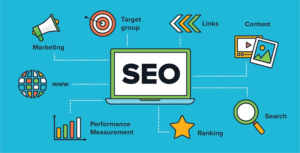Search engine optimization (SEO) is an important marketing strategy that can help you improve your online visibility and attract more customers. However, it can be a complex and time-consuming process.
Fortunately, this guide will provide you with the latest SEO Oklahoma City strategies and practices to help you boost your online visibility and improve your ranking on search engines.

Keyword Research
Keyword research is a crucial step in any SEO campaign. It allows you to understand what your audience is searching for online, which in turn helps you create content that ranks well organically on search engines like Google. It also helps you prioritize your content marketing efforts and spend business resources more effectively.
The process of conducting keyword research starts with brainstorming a list of possible keywords and phrases that relate to your product or service. This can be as broad or as specific as you want, depending on your target audience and what they’re looking for. Then, you can use a keyword research tool to find keywords that are popular among your audience. The best tools are free to use, although there are premium options available as well.
After you’ve identified a list of potential keywords, you can start narrowing them down by evaluating their traffic potential, keyword difficulty, and business potential. Ideally, you’ll be able to identify keywords that are popular among your audience and that are relevant to your business goals. In addition, you’ll want to consider the search intent behind a keyword. For example, if someone searches “men’s chest workouts,” they likely have a different intent than someone who searches “best exercises to lose weight.”
Once you’ve narrowed down your keyword list, it’s time to start creating content that matches those keywords. This can be in the form of blog posts, videos, or other pages on your website. Remember to focus on delivering quality content that answers your audience’s questions and concerns. If you can do this, your audience will be more likely to interact with your content and convert it into customers.
On-page Optimization
If you’ve ever wondered how pages ranking at the top of SERPs manage to achieve their position, there’s a lot of work going on behind the scenes. That work is on-page optimization. On-page optimization is the process of optimizing a page’s content, metadata, and URL to improve its visibility in search engine results pages (SERPs).
This involves making sure that the keywords mentioned on the page are relevant to users searching for those words or phrases. It also means naturally using those keywords so that the text reads well. This is a much more sophisticated approach to SEO than the past practice of keyword stuffing, which involved mentioning the same word or phrase over and over again to rank higher in SERPs.
Other elements of on-page optimization include quality content, meta tags, headers, internal linking, and image optimization. The goal is to ensure that the page meets the user’s search intent and provides a valuable experience. These elements also help search engines understand the relevance of a page and rank it accordingly.
While on-page optimization is an important part of SEO, it’s only a small part of the overall effort. Off-page optimization and technical SEO are also necessary to get the best possible rankings in SERPs. But on-page optimization is a place where marketers can have more control since they can directly impact many of the factors that influence search engine ranking algorithms. In addition to this, on-page optimization can also be complementary to off-page efforts by building brand authority and trust. For example, earning high-quality backlinks and high domain metrics can demonstrate that a website is authoritative and trustworthy.
Content Strategy
A solid content strategy can help you boost your SEO rankings and drive traffic to your website. It starts with defining your goals, which is important for both the long-term and the short-term. This can be as simple as determining whether you want to increase brand awareness, generate leads, or improve customer engagement. Using a goal-planning tool like the SMART framework can help you make these broad goals more specific and actionable. Defining your target audience, or buyer persona, is also a critical component of a content strategy. This is a semi-fictional representation of your ideal customers based on data and research. Identifying your target audience can help you determine what type of content to create and what channels to use.
Once you’ve defined your goals, you need to create a content schedule that will help you achieve them. This can include a weekly or monthly content calendar, blog posts, social media updates, videos, infographics, case studies, and other types of digital content. The key to a successful content strategy is to be consistent and keep up with the pace of your target market’s needs.
Finally, you need to measure your content performance. This can be done by tracking metrics such as organic search traffic, indexed pages, and conversions. You can then analyze and revise your content strategy accordingly.
In a business environment, it’s not uncommon for different departments to have their content strategies. This can lead to confusion and misalignment. To avoid this, it’s important to create a shared vocabulary and understand the role of each type of content in your marketing strategy. This will ensure everyone is on the same page when it comes to how your content will support your business objectives.
Off-page Optimization
Aside from the optimization of your website’s on-page elements, off-page SEO is another critical factor for ranking well in search engine results pages (SERPs). This technique involves acquiring links from other websites that boost your site’s authority and credibility. Depending on the off-page SEO tactics used, this can include link building, social media marketing, brand mentions, guest blogging, and influencer outreach.
When done correctly, off-page SEO can help your business achieve its online goals of driving traffic, generating leads, and increasing sales. To begin, you must identify your business’s goals and target audience. This information will guide your content and outreach efforts. It’s also important to set realistic expectations for your off-page SEO strategy. This includes the length of time it will take for your content to rank, as well as how much traffic you expect to drive from off-page SEO efforts.
Off-page SEO can have a huge impact on the visibility of your content and how it ranks in search engines. However, there are a few things you need to keep in mind when implementing this strategy. For example, off-page SEO is only effective when the quality of the links you acquire is high. This is because backlinks are a primary ranking signal for Google and other search engines, and the more quality links you have, the higher your content will rank in search engine results pages.
Additionally, it’s important to focus on earning quality backlinks from sites that have a lot of link equity (i.e., they have a high domain authority). In addition to backlinks, off-page SEO can also include other online marketing activities, such as social media engagement, generating online reviews, and getting your brand mentioned in publications and on other websites. These activities can help you improve your online reputation, boost your off-page SEO efforts, and increase your website’s domain authority.
Link Building
Link building is a key aspect of SEO. It involves acquiring one-way links (also known as backlinks) to your content to increase your search engine visibility. These links should be relevant to your topic, and they should be from authoritative sites. Link building is a challenging process that requires knowledge of SEO, networking skills, and patience. There are several different techniques for getting quality links, including creating compelling content, building useful tools, and email outreach.
Before Google’s PageRank algorithm, search engines ranked results based on the number of websites that linked to them. This led to the term “link building” to describe how marketers and webmasters acquired links. Today, search engines like Google use a variety of factors to rank results but still consider the number of links to be an important factor.
There are a variety of ways to build links, and some may be more effective than others. For example, you can create a guest post on a highly-ranked website and include a link to your site. However, this kind of link is often labeled with a rel=”nofollow” tag, which tells search engines not to count it as an endorsement.
Other methods for building links include broken link building, image link building, and HARO (Help a Reporter Out). You can also learn how to spy on your competitors’ backlinks with a tool such as the CBLT. However, be careful not to engage in spammy tactics that could put your business at risk. For example, exchanging money for links is against Google’s guidelines. Instead, try to find creative ways to get links, such as by creating interesting content or by becoming an industry expert.
